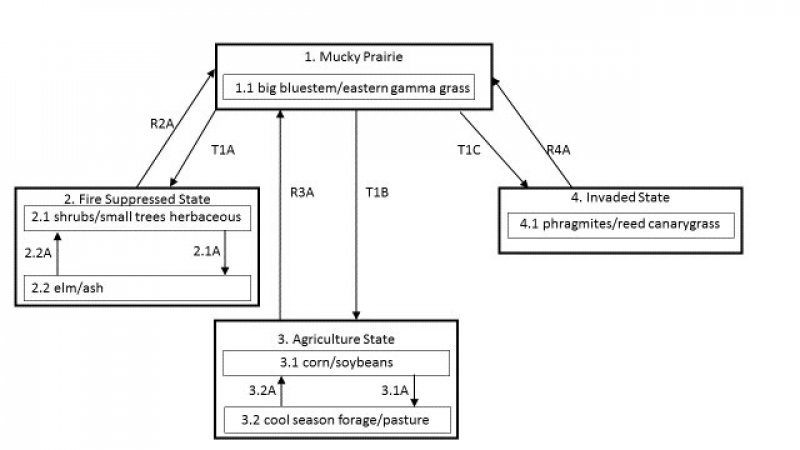
Natural Resources
Conservation Service
Ecological site R111XB002IN
Limnic Muck
Last updated: 9/11/2024
Accessed: 12/21/2025
General information
Provisional. A provisional ecological site description has undergone quality control and quality assurance review. It contains a working state and transition model and enough information to identify the ecological site.
MLRA notes
Major Land Resource Area (MLRA): 111X–Indiana and Ohio Till Plain
111B – Indiana and Ohio Till Plain, Northeastern Part. This area is in the Eastern Lake and Till Plains Sections of the Central Lowland Province of the Interior Plains. The entire MLRA is glaciated, and most areas are dominated by ground moraines that are broken in places by lake plains, outwash plains, flood plains, and many recessional moraines. The ground moraines and lake plains in front of the recessional moraines are flat to undulating. In many places stream valleys occur at the leading edge of the recessional moraines. Narrow, shallow valleys commonly are along the major rivers and streams in this MLRA, and some areas along the major rivers and streams have deposits of sand. Elevation ranges from 630 to 1,550 feet (190 to 470 meters), increasing gradually from west to east. Relief is mainly a few meters, but in some areas hills rise as much as 100 feet (30 meters) above the adjoining plains.
The extent of the major Hydrologic Unit Areas (identified by four-digit numbers) that make up this MLRA is as follows: Western Lake Erie (0410), 41 percent; Wabash (0512), 28 percent; Scioto (0, 28 percent; Scioto (0506), 10 percent; St. Clair-Detroit (0409), 9 percent; Great Miami (0508), 6 percent; Southeastern Lake Michigan (0405), 5 percent; and Southwestern Lake Huron (0408), 1 percent. The Huron River in Michigan, Cedar Creek in Indiana, and the Sandusky River in Ohio have been designated as National Wild and Scenic Rivers in this MLRA.
The surficial materials in this area include glacial deposits of till, outwash, and lacustrine sediments from Wisconsin and older glacial periods. A thin mantle of loess occurs in some areas. Most of the MLRA is underlain by Silurian and Devonian limestone and dolostone. Middle Devonian to Early Mississippian black shale and Early to Middle Mississippian siltstone and shale are in some areas of the northern part of the MLRA.
Classification relationships
Major Land Resource Area (USDA-Natural Resources Conservation Service, 2006)
USFS Ecological Regions (USDA, 2007):
Sections –Central Till Plains, Beech Maple (222H), South Central Great Lakes (222J)
Subsections – Bluffton Till Plains (222Ha), Bluffton-Ann Arbor Till Plains (222Je), Jackson Interlobate Moraine (222Jg), Steuben Interlobate Moraines (222Ji)
NatureServe Systems anticipated (NatureServe, 2011): Agriculture - Cultivated Crops and Irrigated Agriculture, Agriculture – Pasture/Hay, North-Central Interior Beech-Maple Forest,
LANDFIRE Biophysical Settings anticipated (USGS, 2010): Central Interior and Appalachian Floodplain Systems, North-Central Interior Beech-Maple Forest
Ecological site concept
This site is an upland site formed on herbaceous organic soil parent material overlaying coprogenic material in depressions on lake and till plains. Disturbance to the site by fire was driven by the seasonal presence of water on the site. In the spring and early summer the site is often ponded to a depth of 15 inches and for up to 30 days. The water table recedes as the summer progresses creating a drier situation. The drier conditions that can occur in very early spring or late fall, coupled with the then dormant vegetation, increases the susceptibility of the site to fire. The seasonal flooding and relatively short fire return interval (~10 years or less) created a situation where the site is dominated by herbaceous vegetation.
The characteristic vegetation is herbaceous in nature, mostly dominated by tall prairie grass species, most notably big bluestem and eastern gamagrass. Sedge species are also common throughout the site and are the most abundant sub-dominant group of species. The influence of water via flooding and ponding along with fire maintain the herbaceous species dominance of the site. The absence of fire will lead this site to being converted to woodland and then potentially a closed canopy forest. The lack of fire will allow hydrophilic shrub species to get established, further altering the fire cycle. Continued absence of fire will have the site progress to a forest dominated by wetland tree species such as elm and ash. Invasive species, specifically, reed canarygrass and phragmites, can invade and come to dominate the site in the absence of management to curtail or prevent their establishment and proliferation. Currently, a large percentage of the site is in agricultural production, notably corn and soybean rotations, after the installation of drainage. These sites can be very productive, once drained, due in large part to the high amounts of organic matter.
Associated sites
| R111XB001IN |
Mineral Muck Mineral Muck. Underlain by mineral soil. |
|---|---|
| R111XB003IN |
Deep Muck Deep Muck. Not underlain by mineral soil. |
| F111XB501IN |
Till Depression Till Depression. On till parent material. |
Similar sites
| R111XB001IN |
Mineral Muck Mineral Muck. |
|---|---|
| R111XB003IN |
Deep Muck Deep Muck. |
Table 1. Dominant plant species
| Tree |
Not specified |
|---|---|
| Shrub |
Not specified |
| Herbaceous |
(1) Andropogon gerardii |
Click on box and path labels to scroll to the respective text.



